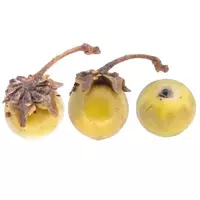Nancy

The exotic plant of Birsonim is thick-leaved or Byrsonima crassifolia, better known by the name nanse, is a fruit tree belonging to the Malpigian family. Researchers call the region of South and Central America the birthplace of the nase plant. Currently, Nancy is successfully cultivated in such states as Cuba, Haiti, Jamaica, the Philippines, the small Antilles, as well as Puerto Rico.
In its appearance and biological structure, the nanse is a small evergreen fruit tree, which rarely reaches a height of 10 meters. The leaves of the nase leathery plant are elliptical in shape. The plant blooms nase with inflorescences of golden or orange color, which are collected in inflorescences. Nansé fruits have a rounded shape, usually in diameter not exceeding 12 cm with a glossy orange-yellow peel.
Fresh nansé fruits are eaten, inside of which there is an oily milky white fruit flesh in color, characterized by its sweet taste and pronounced sharp smell. In addition, a hard stone of irregular shape can be found in the fruits of the nancy. It is noteworthy that the fruits of Nancy are eaten not only fresh, but also cooked.
Typically, the nansé fruits are boiled and served as a dessert. In addition, nanse fruits are used as ingredients in the process of preparing some exotic main dishes, soups, as well as sauces. In countries where the nanse tree grows from time immemorial, fruit fruits are used to make national alcoholic beverages.
In addition, the fruit flesh of Nancy is perfect for the production of refreshing and carbonated drinks. If mature nanse fruits are consumed, green and green fruits are used as a natural natural dye of cotton fabrics. Natural coloring substances contained in the skin of Nansé fruits are able to stain a slightly brown tint.
The bark of the nanse tree has been used for thousands of years to make medicinal infusions, which are considered an effective means of traditional medicine. Infusion from the bark of the Nanse tree has astringent properties, and also contribute to a decrease in temperature for colds and some viral diseases. The main feature of the fruits of the Nanse tree can be considered that the fruit perishable outdoors can retain its taste and consumer characteristics for several months if poured with water.
The nanse tree is distinguished by its unpretentiousness and the ability to produce the first harvest in the third or fourth year of the plant's life. In addition, professionals argue that some varieties of nansé can be easily grown at home, the main thing is to create certain conditions.
Nancy 73 kCal
Energy value of nanse (Ratio of proteins, fats, carbohydrates - ju):
Proteins: 0.66 g (~ 3 kCal)
Fats: 1.16 g (~ 10 kCal)
Carbohydrates: 0 g (~ 0 kCal)
Energy ratio (bj | y): 4% | 14% | 0%
 Español
Español Français
Français Português
Português Русский
Русский 简体中文
简体中文 繁體中文
繁體中文 日本語
日本語 한국어
한국어 العربية
العربية Türkçe
Türkçe Қазақ
Қазақ Deutsch
Deutsch Italiano
Italiano Українська
Українська
